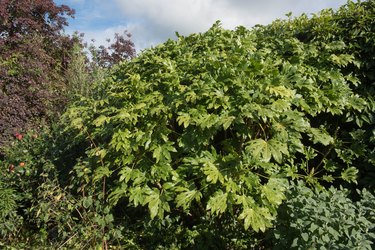
Shade-loving plants with style are hard enough to find without added worry about their pet-friendliness. For a made-for-the-shade shrub with dramatic year-round architectural interest, tropical flair and absolutely nothing for the family cat to fear, consider Fatsia japonica. Commonly known as Japanese aralia, this striking shrub grows in partial to full shade across U.S. Department of Agriculture plant hardiness zones 8 though 10 and as an indoor cat-safe plant elsewhere.
Protecting Puss from Herself with Cat-safe Plants
Video of the Day
As many as 1 of every 3 house cats occasionally treats the local vegetation as a salad bar. Some do it out of boredom, some may do it to relieve a tummy ache or loosen a hairball, and many do it for reasons known only to cats. It is believed that cats often find plants tasty; that they may enjoy the textures and might even be intrigued by the movements of leaves and fronds in the breeze.
Video of the Day
Whatever kitty's motivation, you can't watch your pet every minute, so having nonpoisonous cat-safe plants is the next best thing. Unless sprayed with toxic bug-, disease- or weed-controlling chemicals, Japanese aralia is harmless to nibbling cats, dogs and people.
That Fantastic Foliage
Picture lustrous, deeply lobed green leaves so heavy -- at up to 16 inches wide -- that they force their sturdy stems to curve, twist and eventually droop to the ground, and you have Japanese aralia. The genus name Fatsia from an archaic Japanese word for "eight" presumably reflects each hand-shaped leaf's seven to nine lobes. Tack on the additional common name of "glossy-leaved paper plant" and you'll understand that Japanese aralia is all about its foliage. White-stalked clumps of small, creamy flowers covering its branch ends in fall and winter give way to clusters of round, black nontoxic spring berries. Consider them afterthoughts and plant this evergreen for its open, spreading habit and bold, bright leaves.
Picking Your Spot
Japanese aralia doesn't ask much in the way of care, but it does insist on partial to full shade, shelter from winter winds and plenty of room to grow. In the right location, with moist, acidic organically rich soil, expect it to reach 6 to 10 feet high with an equal spread. In rare instances, the plants reach 16 feet. Once established, they spread by suckers. Kitty might see an aralia forest as the perfect place to lie in wait before pouncing, but unless you dig up the suckers as they appear, this cat-safe plant eventually outgrows its designated boundaries.
Removing Temptation of Cat-safe Plants
Even though munching on cat-safe plants such as Japanese aralia won't poison your cat, it's never wise to let a pet wander around snacking at will. A stray leaf or splintered twig could easily lodge in kitty's throat or intestines.
If you can't put your plant out of kitty's reach, simply make it less appealing. Try spraying plants your cat finds irresistible with water, then sprinkling them with cayenne pepper as a deterrent. Cats find citrus flavors completely distasteful, so dilute some orange, lime or lemon juice with a little water and spritz chewable plants with the concoction. Or consider giving kitty her own plant. Distract her from her undesirable nibbling with a nice pot of cat grass, such as a blend of wheat, rye and barley. Cat grass is available commercially, or give growing your own a shot.